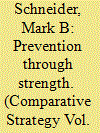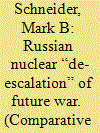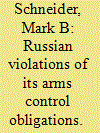|
|
|
Sort Order |
|
|
|
Items / Page
|
|
|
|
|
|
|
| Srl | Item |
| 1 |
ID:
112861


|
|
|
|
|
| Publication |
2012.
|
| Summary/Abstract |
For five decades, the Minuteman ICBM has served the nation well as the most affordable and responsive element of the U.S. nuclear TRIAD. It has secure command and control, high readiness rates, and low operating costs. The existence of the ICBM force provides critical protection for the other legs of the U.S. deterrent. While the ICBM force has thus far survived defense cuts, a follow-on ICBM is needed, design skills are rapidly disappearing, and the solid rocket motor industrial base is shrinking. Maintenance of the nuclear TRIAD is critical, but it is clearly at risk, despite the fact that both the Russians and Chinese are deploying new ICBMs and developing still more modern ones with the intent to deploy them.
|
|
|
|
|
|
|
|
|
|
|
|
|
|
|
|
| 2 |
ID:
123437


|
|
|
|
|
| Publication |
2013.
|
| Summary/Abstract |
It is possible that Iran has covertly acquired a very small number of nuclear weapons and that these have been tested by North Korea. There are an increasing number of reports to this effect going back to 2007 when the London Daily Telegraph reported that with North Korean help Iran could obtain a "low-grade device-less than half a kiloton-within 12 months." According to The New York Times concerning the 2013 North Korean nuclear test, a senior Obama administration official concluded that "it's very possible that the North Koreans are testing for two countries." A.Q. Kahn proliferated detailed technical information not only on the original Chinese CHIC-4 nuclear weapons design but also on a smaller version of the design tested by Pakistan in 1998. If Iran has covertly acquired nuclear weapons, they are likely to be very few in number and low yield. There may still be time to prevent the development by Iran of an extensive nuclear weapons capability but the continuation of the current ineffective diplomacy will not do it.
|
|
|
|
|
|
|
|
|
|
|
|
|
|
|
|
| 3 |
ID:
087987


|
|
|
|
|
| Publication |
2009.
|
| Summary/Abstract |
The proliferation of weapons of mass destruction is clearly one of the greatest security threats the Western world faces today. Counterproliferation has been one of the core objectives of the Bush administration from its first days in office. While there is bipartisan support in the United States for the concept that proliferation represents a serious threat, there is substantial disagreement on how to deal with this threat.
|
|
|
|
|
|
|
|
|
|
|
|
|
|
|
|
| 4 |
ID:
164628


|
|
|
|
|
| Summary/Abstract |
Putin developed Russia’s nuclear strategy, which allows for the first use of nuclear weapons in conventional war, when he was secretary of the Russian National Security Council Staff. Russian nuclear doctrine allows for the first use of nuclear weapons in “regional or even a local” war. Starting in 1999, Russia began to simulate the first use of nuclear weapons in large, theater-war exercises. Since 2000, all large-scale Russian military exercises have reportedly featured simulations of limited Russian nuclear strikes. Russia characterizes the first use of nuclear weapons as “de-escalation” of aggression. There is an impressive body of evidence going back decades indicating that Soviet/Russia’s threshold of nuclear weapons first use is lower than what was publicly announced. Indeed, in 2014, General of the Army (ret.) Yuri Baluyevskiy, who managed the development of Russia’s nuclear doctrine, said that the “conditions for pre-emptive nuclear strikes…is contained in classified policy documents.” Since 2007, Russia has made numerous high-level overt nuclear threats, including, since 2014, nuclear threats relating to Ukraine and the Baltics. Putin is preparing for a major war with the U.S. and NATO. He clearly hopes the West will capitulate without one. If he miscalculates and a war results, the threat of nuclear strikes, and possibly the strikes themselves, will be a major part of his strategy for victory.
|
|
|
|
|
|
|
|
|
|
|
|
|
|
|
|
| 5 |
ID:
115341


|
|
|
|
|
| Publication |
2012.
|
| Summary/Abstract |
The Soviet Union and its successor state the Russian Federation have consistently violated their arms control obligations since the beginning of modern arms control in 1972. The violations have involved all major nuclear arms control treaties, including those that limit strategic and theater nuclear arms and constrain nuclear testing. This pattern of behavior is certain to continue. As a result, the nuclear warheads on the Russian missiles apparently will have been tested in contravention of a declared nuclear test moratorium and Russia's legal obligations concerning the CTBT. There is almost never any consequence for these violations. These violations have clear military significance, and they should have an impact upon our views of arms control. Regrettably, they do not. The evidence is more often suppressed than provided to the American people and we continue to ignore it in our arms control policy.
|
|
|
|
|
|
|
|
|
|
|
|
|
|
|
|
|
|
|
|
|